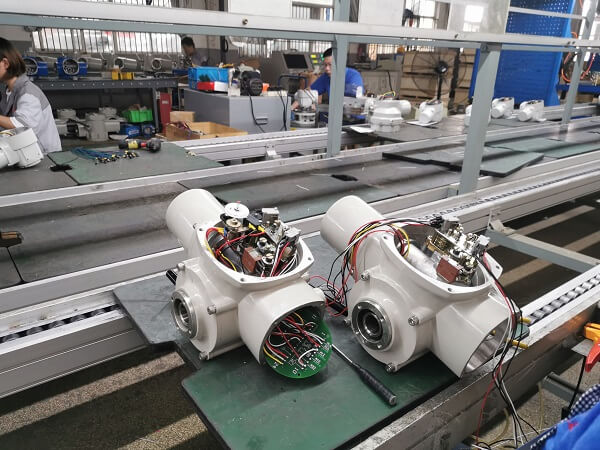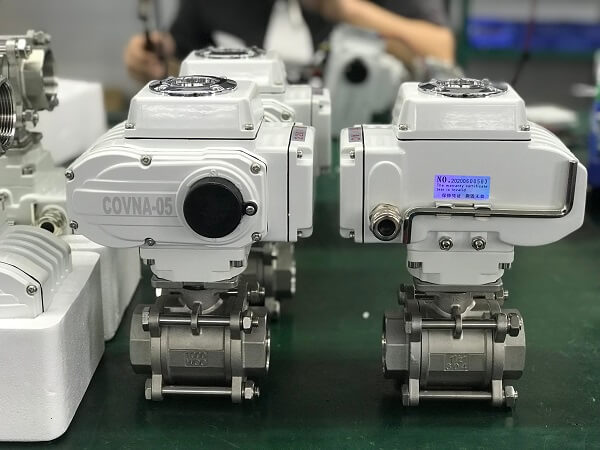1. Valve Selection
1.1 Rotary Valves (Single-Turn Valves)
These valves include: plug valves, ball valves, butterfly valves, and valves or baffles. These valves require an actuator that has the required Torque for a 90 degree rotation operation.
1.2 Multi-turn Valves
These valves may be non-rotating or rotating non-lifting stems, or they may require additional rotation to drive the valve to the open or closed position. Such valves include: Through valve (globe valve) , gate valve, knife gate valve and so on. Alternatively, a straight-line output pneumatic or hydraulic cylinder or film actuator is also opened to drive the valve.
2. Actuator Selection:
2.1 Electric Multi-Turn Actuator
Electric power driven multi-rotary actuator is one of the most commonly used and reliable actuator types. A single-phase or three-phase motor drives a gear or worm wheel to finally drive the stem nut, which moves the stem to open or close the valve.
Multi-turn electric actuator can drive large size valve quickly. In order to protect the valve from damage, the limit switch installed at the end of the valve stroke will cut off the motor power supply, and when the safety torque is exceeded, the torque inductor will also cut off the motor power supply position switches are used to indicate the on-off status of the valve. A clutch-mounted handwheel mechanism operates the valve manually in the event of a power failure.
The main advantage of this type of actuator is that all the components are installed in a housing that integrates all the basic and advanced functions in a waterproof, dust-proof, explosion-proof housing. The main disadvantage is that when the power failure, the valve can only remain in place, only using the standby power system, the valve can achieve a fault safe position (fault open or fault closed)
2.2 Electric Single Rotary Actuator
This actuator is similar to the electric multi-turn actuator, the main difference is that the final output of the actuator is 1/4 of a 90-degree rotation motion. The new generation of single-rotation electric actuator combines the complex functions of most multi-rotation actuators, such as parameter setting and diagnosis using non-entry user-friendly interface.
Single rotary actuators are compact and can be mounted on small size valves, usually with an output torque of up to 800kg, and because they require less power, they can be fitted with batteries for fail safe operation.
2.3 Fluid-driven Multi-turn Or Linear Output Actuators
This type of actuator is often used to operate through valves (globe valves) and gate valves, which are operated pneumatically or hydraulically. The utility model has the advantages of simple structure, reliable operation and easy realization of the failure safe operation mode.
Electric multi-turn actuators are usually used to drive gate and globe valves, and hydraulic or pneumatic actuators are only considered when power is not available.
2.4 Fluid Driven Single Rotary Actuator
Pneumatic and hydraulic single rotary actuators are very common, they do not need power and simple structure, reliable performance. They have a wide range of applications. The usual output ranges from a few kilograms of meters to tens of thousands of kilograms of meters. They use cylinders and actuators to convert linear motion to right-angle output, usually with a fork, rack and Pinion, or lever. Gear rack output in the full range of the same torque, they are very suitable for small size valves, fork with high efficiency at the start of the trip with high torque output is very suitable for large diameter valves. Pneumatic actuator generally installed solenoid valve, positioner or position switch accessories to achieve the control and monitoring of the valve.
This type of actuator makes it easy to implement the fail-safe mode of operation.
3. Implementing Agency Selection Elements
The following three elements must be considered when selecting a suitable valve actuator type and specification:
3.1 Driving Power
The most commonly used driving energy is power or fluid source, if choose power for driving energy, for large-size valves generally choose three-phase power, for small-size valves can choose single-phase power. General electric actuator can be a variety of power types to choose from. Sometimes DC power supply can be selected, at this time through the installation of batteries to achieve power failure safe operation.
There are many types of fluid sources, first of all, they can be different media such as: Compressed air, nitrogen, natural gas, hydraulic fluid, etc. . Second, they can have a variety of pressure, third actuator has a variety of sizes to provide output force moment.
3.2 Valve Type
When selecting an actuator for a valve, it is important to know the type of valve so that the correct actuator type can be selected. Some valves require multi-turn actuation, some require single-turn actuation, and some require reciprocating actuation, which affects the choice of actuator type.
Multi-turn pneumatic actuators are usually more expensive than electric multi-turn actuators, but the reciprocating direct-stroke output pneumatic actuators are cheaper than electric multi-turn actuators.
3.3 Torque
For 90 degree rotary valve such as: Ball valve, disc valve, plug valve, the best through the valve manufacturers to obtain the corresponding valve torque size, most valve manufacturers are by testing the valve at rated pressure required operating Torque, they provide this torque to the customer. For multi-turn valve situation is different, these valves can be divided into: reciprocating (lifting) movement-stem non-rotation, reciprocating movement-stem rotation, non-reciprocating-stem rotation, stem diameter must be measured, stem connection thread size determines actuator specifications.
4. Type Selection Of Actuator
Once the actuator type and the required driving torque of the valve are determined, the actuator can be selected using a data sheet or type selection software provided by the actuator manufacturer. Sometimes the speed and frequency of valve operation need to be considered.
The fluid-driven actuator can adjust the travel speed, but the electric actuator with three-phase power only has a fixed travel time.
Part of the small size of DC electric single-rotation actuator can adjust the travel speed.
4.1 Switch Control
The great advantage of the automatic control valve is that the valve can be operated remotely, which means that the operator can sit in the control room and control the production process without having to manually operate the Valve on-and off-site. One only needs to lay a few lines to connect the control room and the actuator to drive the energy directly through the pipeline to the electric or pneumatic actuator, usually 4-20mA signal to feedback the position of the valve.
4.2 Continuous Control
If the actuator is required to control the liquid level, flow rate or pressure of the process system, which is a work that requires frequent action of the actuator, the 4-20mA signal can be used as the control signal. However, the signal may change as frequently as the process. If you need very high frequency action of the executive body, only select a special frequency can start and stop the adjustment of the executive body. When more than one actuator is needed in a process, the actuator can be connected by using a digital communication system, which greatly reduces the installation cost. Digital communication loop can quickly and efficiently transfer instructions and collect information. Not only can digital communication systems reduce investment costs, they can also collect a large amount of valve information, which is very valuable for predictive valve maintenance procedures.
Post time: Jul-28-2021






